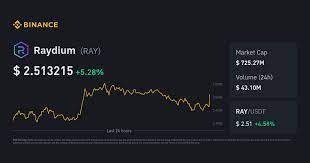Binance vs. Raydium (RAY): A Comparative Analysis of Liquidity Pools in the DeFi Ecosystem
The world of decentralized finance (DeFi) has seen rapid growth, with platforms like Binance and Raydium emerging as key players in liquidity provision and trading. While Binance is a centralized exchange (CEX), Raydium is a decentralized exchange (DEX) built on the Solana blockchain. This article delves into the concept of liquidity pools on Raydium, clarifies common misconceptions, and explores the factors that influence their performance.
Understanding Raydium: A Solana-Based DEX
Raydium is a Decentralized Exchange (DEX) on the Solana blockchain, developed by the team behind Serum, a high-performance decentralized exchange. Unlike Binance, which operates as a centralized platform offering trading, staking, and margin services, Raydium leverages Solana’s fast, low-cost infrastructure to provide automated market maker (AMM) functionality and concentrated liquidity pools.
A liquidity pool is a smart contract that holds funds to facilitate automated trading on DEXs. Users (liquidity providers, or LPs) deposit assets into these pools to earn trading fees and other rewards. Raydium’s unique concentrated liquidity model (introduced via Uniswap v3’s mechanism) allows LPs to specify price ranges for their assets, increasing capital efficiency and potential returns.
However, a critical note: Raydium is not a Binance product. Binance and Raydium operate on different blockchains (Binance Chain vs. Solana), and their liquidity pools are distinct. If the query refers to a Binance-specific liquidity pool for RAY (Raydium’s native token), it’s worth clarifying that RAY is primarily listed on Solana-based platforms and is not native to Binance. Binance may offer trading pairs involving RAY, but the liquidity pools themselves are managed by Raydium.
Key Metrics for Analyzing Raydium Liquidity Pools
To evaluate the health and performance of Raydium’s liquidity pools, consider the following metrics:
1. Total Value Locked (TVL)
TVL measures the total amount of assets deposited into liquidity pools. Raydium has consistently ranked among the top DEXs on Solana in terms of TVL, driven by its integration with Serum’s order book and its ability to offer high-efficiency liquidity. For example, as of 2023, Raydium’s TVL often exceeded $100 million, though this fluctuates based on market conditions.
Why it matters: A higher TVL indicates strong user adoption and trust in the platform. However, it’s not a guarantee of profitability, as it can be affected by market volatility and asset price changes.
2. Trading Volume and Fee Revenue
Raydium’s liquidity pools generate trading fees (typically 0.1–0.3%) from transactions. These fees are distributed to LPs and sometimes used for token burn mechanisms to reduce supply and increase scarcity. The platform’s low gas fees on Solana (compared to Ethereum) and fast transaction speeds have boosted user activity.
Key Insight: Raydium’s hybrid model (combining an order book with AMM) attracts both limit-order traders and liquidity providers, creating a more dynamic trading environment.
3. RAY Token Utility and Rewards
The RAY token is central to Raydium’s ecosystem. It serves as:
- Governance: Enabling token holders to vote on protocol upgrades.
- Staking: Users can stake RAY to earn rewards from transaction fees and other protocols.
- Liquidity Incentives: Raydium often offers bonus rewards for LPs who stake RAY in specific pools.
These incentives drive participation but also expose users to reward dilution risks, as new pools with higher rewards can siphon funds from existing ones.
Factors Influencing Raydium Liquidity Pools
Several elements shape the performance of Raydium’s liquidity pools:
-
Market Trends:
- Volatility in major assets (e.g., SOL, USDC, ETH) directly impacts TVL and LP earnings.
- Bullish or bearish cycles in Solana’s ecosystem can attract or repel liquidity providers.
-
Competitive Landscape:
- Raydium competes with other Solana DEXs like Orca and SushiSwap. Its concentrated liquidity model and integration with Serum give it an edge, but newer projects may disrupt this.
-
Protocol Upgrades:
- Improvements to Raydium’s codebase, such as new fee structures or enhanced yield opportunities, can attract more liquidity.
-
Cross-Chain Integration:
- As Solana expands through partnerships (e.g., with Ethereum via Wormhole or layer-2 solutions), Raydium’s liquidity pools may see increased activity from cross-chain assets.
- Tokenomics and Governance:
- Changes to RAY’s distribution, such as airdrops or liquidity incentives, can shift user behavior. For example, early RAY holders often received rewards to bootstrap liquidity.
Risks and Challenges of Raydium Liquidity Pools
While Raydium offers attractive opportunities, LPs must be aware of the following risks:
1. Impermanent Loss
LPs face the risk of impermanent loss when the price of deposited assets deviates from the initial deposit range. This is more pronounced in volatile markets.
2. Smart Contract Vulnerabilities
As with all DeFi platforms, bugs or exploits in Raydium’s code could drain liquidity. Rigorous audits and security measures are critical to mitigate this.
3. Low Adoption of New Pools
New liquidity pools on Raydium may struggle to attract sufficient capital, leading to slippage issues and reduced fee earnings for LPs.
4. Regulatory Uncertainty
Global regulatory scrutiny of DeFi protocols could impact liquidity and user activity, though Raydium’s Solana focus may reduce its exposure compared to more regulated markets.
Opportunities for Raydium Liquidity Providers
Despite risks, Raydium’s liquidity pools present compelling opportunities:
- High-Yield Farming: Seasoned LPs can earn excess returns by optimizing price ranges and participating in yield farming.
- Cross-Chain Synergy: As Solana interoperates with other chains, Raydium may see diverse liquidity sources (e.g., ETH, BTC).
- Token Burn Mechanisms: Raydium’s quarterly RAY token burns can create deflationary pressure and support price appreciation.
- DeFi Ecosystem Growth: Solana’s fast adoption and low costs position Raydium to capitalize on the expanding DeFi market.
Conclusion: Raydium’s Liquidity Pools in the DeFi Landscape
Raydium’s liquidity pools are a cornerstone of its ecosystem, offering a hybrid model that combines the efficiency of AMMs with the order-book-driven trading of Serum. While not tied to Binance, Raydium’s integration with Solana provides a competitive edge over traditional centralized exchanges.
For users, the key is to understand the risks (such as impermanent loss and smart contract vulnerabilities) while leveraging the high rewards and capital efficiency of concentrated liquidity. As Solana continues to grow, Raydium’s liquidity pools could become even more significant, but due diligence and research are essential to navigating this dynamic space.
FAQ: What You Need to Know
Q: Is Raydium available on Binance?
A: No. Raydium is a Solana-based DEX, while Binance operates on its own blockchain. However, Binance may list RAY as a trading pair, but the liquidity pools themselves are not managed by Binance.
Q: How do Raydium liquidity pools differ from Binance’s?
A: Binance’s liquidity is centralized, relying on market makers, while Raydium’s are decentralized and driven by community-provided pools.
Q: What are the risks of providing liquidity on Raydium?
A: Impermanent loss, smart contract risks, and market volatility are primary concerns. Always assess price trends and pool health before investing.
Q: Can I earn RAY tokens from liquidity pools?
A: Yes. LPs can earn RAY tokens as rewards for contributing liquidity, while also collecting trading fees from the pool.
Q: How is Raydium’s TVL affected by Solana’s network performance?
A: Solana’s scalability and low fees attract liquidity, but network outages or slowdowns could temporarily reduce activity.
Note: For the most accurate and up-to-date liquidity pool data, check platforms like DefiLlama or Raydium’s official dashboard.
This analysis underscores the importance of understanding the unique mechanics of DeFi platforms like Raydium, which offer powerful tools for earning returns but require careful risk management. As the DeFi space evolves, so will the strategies for maximizing yield in liquidity pools.







